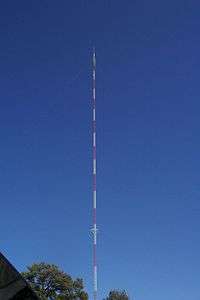Arkansas Educational Television Network
 | |
| statewide Arkansas United States | |
|---|---|
| Branding | AETN |
| Channels | Digital: see table below |
| Subchannels | see table below |
| Affiliations | PBS |
| Owner | Arkansas Educational Television Commission |
| First air date | December 4, 1966 |
| Former affiliations | NET (1966–1970) |
| Transmitter power | see table below |
| Height | see table below |
| Facility ID | see table below |
| Transmitter coordinates | see table below |
| Licensing authority | FCC |
| Public license information: |
Educational Television Network Profile Educational Television Network CDBS |
| Website | www.aetn.org |
The Arkansas Educational Television Network (or AETN) is a state network of PBS member television stations serving the U.S. state of Arkansas. It is operated by the Arkansas Educational Television Commission, an agency of the Arkansas state government which holds the licenses for all the PBS member stations licensed in the state. The broadcast signals of the six stations that are part of the public television network cover almost all of the state, as well as portions of Mississippi, Tennessee, Missouri, Oklahoma, Texas and Louisiana.
AETN's offices and network operations are based out of the R. Lee Reaves Center for Educational Telecommunications, located adjacent to the University of Central Arkansas in Conway; its programming is distributed via a thirteen-site microwave interconnection relay system around the state, which covers most of Arkansas, as well as parts of all surrounding states.
Approximately two-thirds of AETN's funding comes from state tax dollars to support the broadcast infrastructure and all services that are provided for educators and schools. More than 10% comes from the federal government as a partial match of what is raised locally. Almost 20% comes from voluntary contributions from individual viewers and businesses.
History
The Arkansas Educational Television Commission was created in 1961, following a two-year legislative study to assess the need for educational television programming in Arkansas. KETS (channel 2) in Little Rock, the flagship station of AETN, first signed on the air as the nation's 124th educational television station on December 4, 1966. In the early years, KETS was associated with National Educational Television, the forerunner of the current PBS. In the station's early years, KETS broadcast its programming black-and-white only, before upgrading to color capabilities in 1972. The station maintained limited hours of operation during its early years, with its programming focused primarily on instructional content for use in Arkansas schools.

For many years, KETS broadcast its signal from a transmitter tower located in Redfield; this tower collapsed on January 11, 2008, during work on adjusting guy wires.[1] KETS's analog signal remained off the air until June 13, 2008, when a temporary analog antenna was installed at the Clear Channel Broadcasting Tower Redfield, where its digital transmitter had already originated.
After nine years of serving only Central Arkansas through KETS, AETN began to launch satellite stations between 1976 and 1980 in order to expand its coverage to virtually the entire state, becoming a full statewide network in the traditional sense. The first three satellites launched over the course of six months in 1976: KTEJ in Jonesboro signed on the air on May 1, KAFT signed on from Fayetteville on September 18 and KETG signed on from Arkadelphia on October 2, 1976; the final of the original satellites to debut was KEMV in Mountain View on November 13, 1980.
AETN's hours of operation gradually expanded over time to 24 hours a day, seven days a week as programming for general audiences was added during the evenings and on weekends. Much of south-central Arkansas was underserved by PBS programming from AETN (receiving only stations from nearby transmitters) until KETZ in El Dorado signed on the air on May 20, 2006. The five analog transmitters eventually converted to digital by mid-2009, joining KETZ (which had operated only a digital signal from launch), as part of the national digital transition.
During the 1960s, 1970s and 1980s, AETN became an educational resource for public school and college educators through the use of instructional videos with teacher guides and supplements for grade school classrooms, college telecourses, and GED education for adults. During the mid-1990s, AETN began providing distance learning via broadcast, satellite, the Internet and compressed video to provide educational professional development as well as access for students to a wide variety of educational courses for classroom use.
AETN began creating local programming in the late 1960s and still annually produces more than 100 hours of full-length, educational and cultural programming specifically about Arkansas.
Stations
AETN's network comprises six digital transmitters which cover almost all of Arkansas, as well as parts of Louisiana, Missouri, Oklahoma, and Tennessee.
| Station | City of license | Channels (Digital) |
VC1 | First air date | ERP | Future ERP | HAAT | Facility ID | Transmitter Coordinates |
| KAFT | Fayetteville | 9 (VHF) | 13 | September 18, 1976 | 37.9 kW | n/a | 501.1 m | 2767 | 35°48′53″N 94°1′41.5″W / 35.81472°N 94.028194°W |
| KEMV | Mountain View | 13 (VHF) | 6 | November 13, 19802 | 12.1 kW | n/a | 407.2 m | 2777 | 35°48′47.1″N 92°17′24.2″W / 35.813083°N 92.290056°W |
| KETG | Arkadelphia | 13 (VHF) | 9 | October 2, 1976 | 13.85 kW | n/a | 319.5 m | 2768 | 33°54′26.6″N 93°6′46.5″W / 33.907389°N 93.112917°W |
| KETS | Little Rock | 7 (VHF) | 2 | December 4, 1966 | 26.73 kW | n/a | 547m | 2770 | 34°26′31.1″N 92°13′3.8″W / 34.441972°N 92.217722°W |
| KTEJ | Jonesboro | 20 (UHF) | 19 | May 1, 1976 | 322.9 kW | n/a | 310.2 m | 2769 | 35°54′11.8″N 90°46′14″W / 35.903278°N 90.77056°W |
| KETZ | El Dorado | 10 (VHF) | 12 | May 20, 2006 | 16.2 kW | n/a | 538 m | 92872 | 33°4′41.7″N 92°13′31″W / 33.078250°N 92.22528°W |
Notes:
- 1. Virtual channel (PSIP).
- 2. The Broadcasting and Cable Yearbook says KEMV signed on November 11, while the Television and Cable Factbook says it signed on November 16.
Digital television
Digital channels
The digital channels of AETN's stations are multiplexed:
| Channel | Video | Aspect | PSIP Short Name | Programming[2][3][4][5][6][7] |
|---|---|---|---|---|
| xx.1 | 720p | 16:9 | (callsign)-1 | Main AETN programming / PBS |
| xx.2 | 480i | 4:3 | (callsign)-2 | AETN 2 (PBS Kids (5:00 p.m.-11:00 p.m.) Create (11:00 p.m.-5:00 p.m.)) |
| xx.3 | (callsign)-3 | AETN Plus (World) | ||
| xx.4 | (callsign)-4 | Arkansas Information Reading Service (audio only; radio reading service) |
Analog-to-digital conversion
During 2009, in the lead-up to the analog-to-digital television transition that would ultimately occur on June 12, AETN shut down the analog transmitters of its stations on a staggered basis. Listed below are the dates each analog transmitter ceased operation as well as their post-transition channel allocations:[8][9]
- KETS shut down its analog signal, over VHF channel 2, on January 25, 2009. The station's digital signal was relocated from its pre-transition VHF channel 5 to VHF channel 7 (the analog allocation formerly used by ABC affiliate KATV). Through the use of PSIP, digital television receivers display the station's virtual channel as its former VHF analog channel 2.
- KTEJ shut down its analog signal, over UHF channel 19, on February 17, 2009, the original date for full-power television stations in the United States to transition from analog to digital broadcasts under federal mandate (which Congress had moved the previous month to June 12). The station's digital signal remained on its pre-transition UHF channel 20. Through the use of PSIP, digital television receivers display the station's virtual channel as its former UHF analog channel 19.
- KEMV shut down its analog signal, over VHF channel 6, on June 12, 2009, the official date in which full-power television stations in the United States transitioned from analog to digital broadcasts under federal mandate. The station's digital signal remained on its pre-transition VHF channel 13. Through the use of PSIP, digital television receivers display the station's virtual channel as its former VHF analog channel 6.
- KAFT shut down its analog signal, over VHF channel 13, on June 12, 2009. The station's digital signal remained on its pre-transition VHF channel 9. Through the use of PSIP, digital television receivers display the station's virtual channel as its former VHF analog channel 13.
- KETG shut down its analog signal, over VHF channel 9, on June 12, 2009. The station's digital signal remained on its pre-transition VHF channel 13. Through the use of PSIP, digital television receivers display the station's virtual channel as its former VHF analog channel 9.
KETZ signed on in May 2006 as a digital-only station, although it also had to endure a temporary shutdown in early 2009 in final preparation for the transition.
References
- ↑ KATV Tower Collapses; Competitors, Comcast Try to Help, Nate Hinkel, Arkansas Business, January 11, 2008
- ↑ RabbitEars TV Query for KETS
- ↑ RabbitEars TV Query for KETZ
- ↑ RabbitEars TV Query for KEMV
- ↑ RabbitEars TV Query for KTEJ
- ↑ RabbitEars TV Query for KETG
- ↑ RabbitEars TV Query for KAFT
- ↑ FCC document: "APPENDIX B: ALL FULL-POWER TELEVISION STATIONS BY DMA, INDICATING THOSE TERMINATING ANALOG SERVICE BEFORE ON OR FEBRUARY 17, 2009."
- ↑ "DTV Tentative Channel Designations for the First and Second Rounds" (PDF). Retrieved 2012-03-24.
External links
- AETN.org
- AETNFoundation.org
- PBS.org
- Arkansas Department of Human Services - Field Services (maintainer of AIRS)
- Query the FCC's TV station database for KETS
- Query the FCC's TV station database for KEMV
- Query the FCC's TV station database for KETG
- Query the FCC's TV station database for KAFT
- Query the FCC's TV station database for KTEJ
- Query the FCC's TV station database for KETZ
- BIAfn's Media Web Database -- Information on KETS-TV
- BIAfn's Media Web Database -- Information on KEMV-TV
- BIAfn's Media Web Database -- Information on KETG-TV
- BIAfn's Media Web Database -- Information on KAFT-TV
- BIAfn's Media Web Database -- Information on KTEJ-TV
- BIAfn's Media Web Database -- Information on KETZ-TV